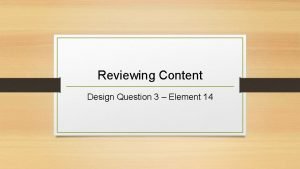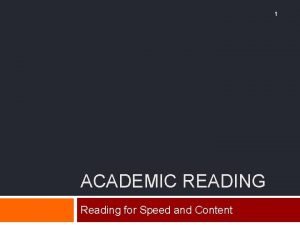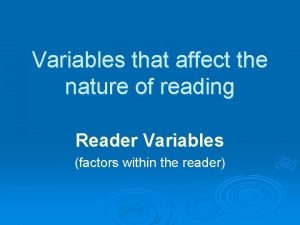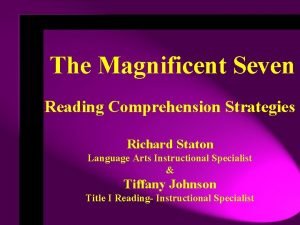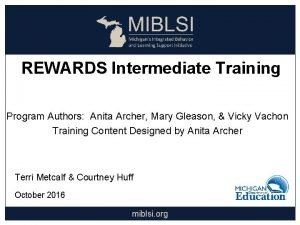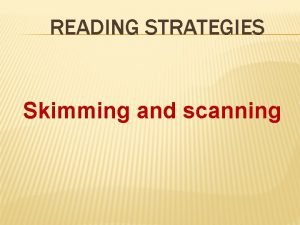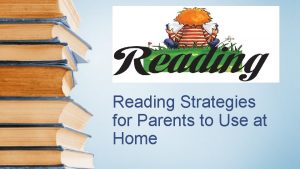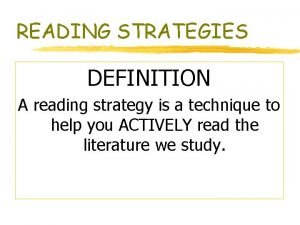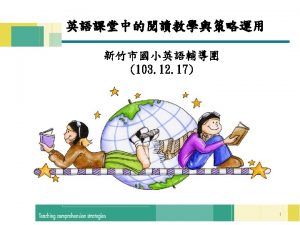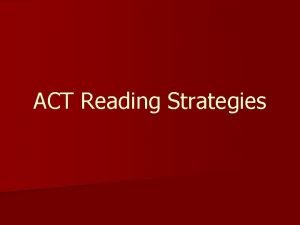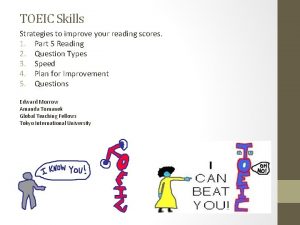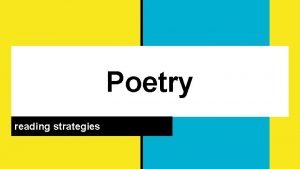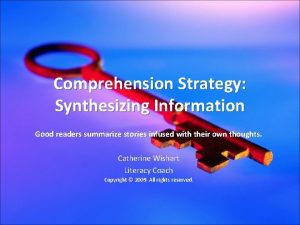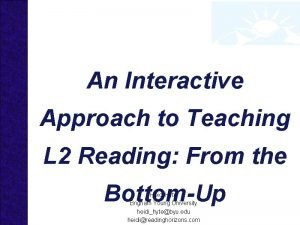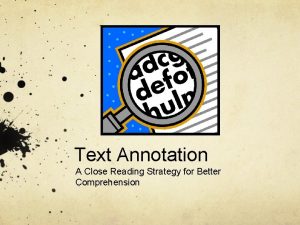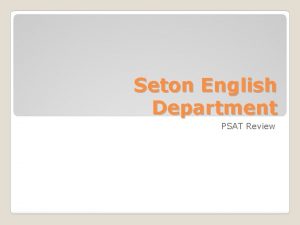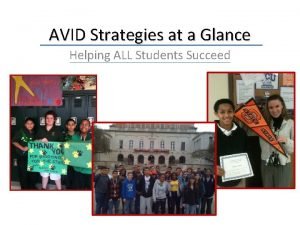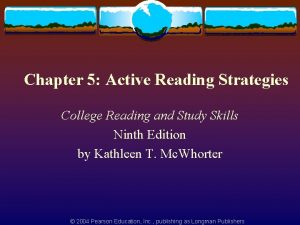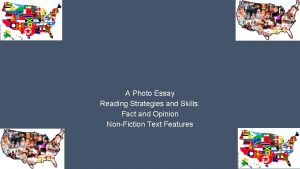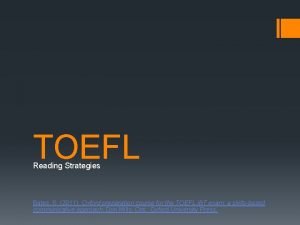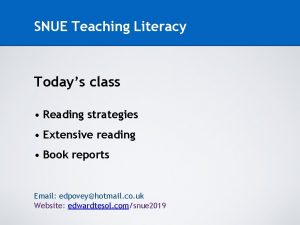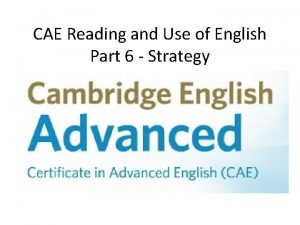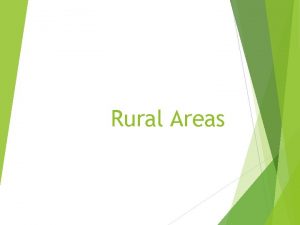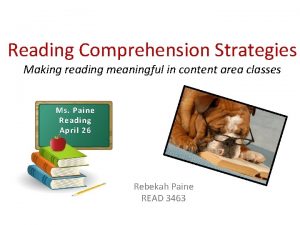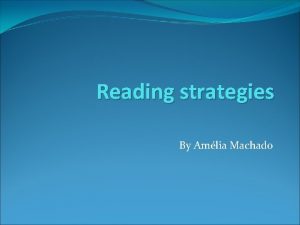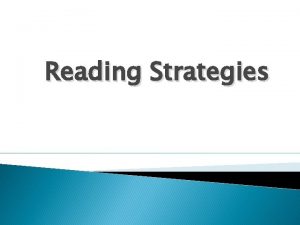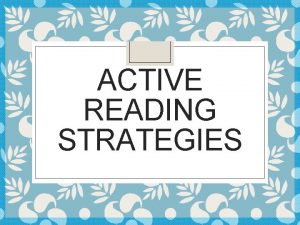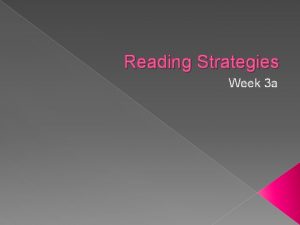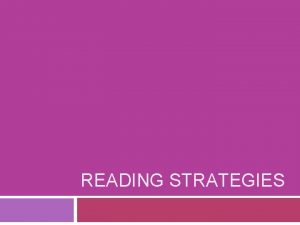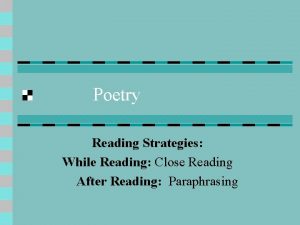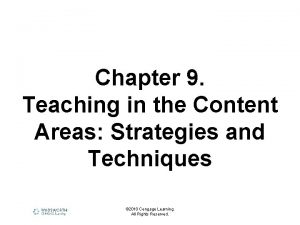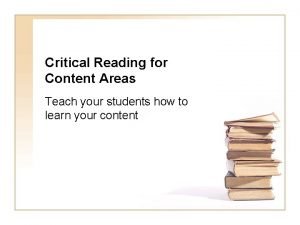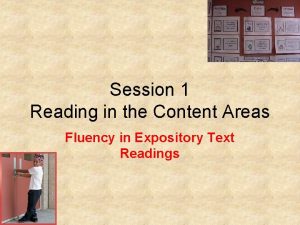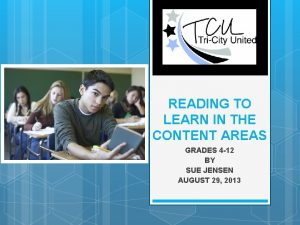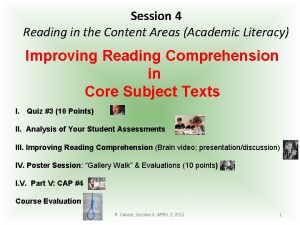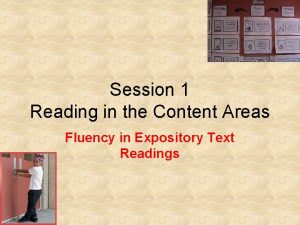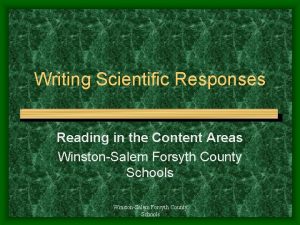Strategies for Reading in the Content Areas Presented






















































- Slides: 54

Strategies for Reading in the Content Areas Presented by Rebecca Derenge Title I Reading Coordinator


Why teach reading in the content areas? What benefits would students gain being able to read about the content with greater understanding?

Reading is the key to success in all content areas!

What about kids who can’t read? • Students who struggle with reading KNOW they struggle with reading: they know they lack the single most important tool for success in school… and they know that not having that skill opens them to ridicule from peers and from teachers. • They do anything they can to distance themselves from the place and the people who will remind them that they can’t read.

Kids who can’t read…. • Non-readers would prefer to get into trouble for not doing their work rather than be embarrassed in front of their peers for doing it wrong. • They KNOW they can’t read; they’ve known it for years. • Not all struggling readers sit at the back of the room, head down, bored look…give the gifted student the right text and s/he can stumble over ideas, worry over words, get lost, and be confused about meaning.

What strategies do you use when you encounter text you don’t understand? What strategies do your STUDENTS use when they encounter text they don’t understand?

Marzano’s 9 Categories of Instructional Strategies That Affect Student Achievement 1. Identifying similarities and differences 2. Summarizing and note taking 3. Reinforcing effort and providing recognition 4. Homework and practice 5. Nonlinguistic representations 6. Cooperative learning 7. Setting objectives and providing feedback 8. Generating and testing hypotheses 9. Questions, cues, and advance organizers

Independent Strategic Readers • Know how to make text make sense • Have strategies to use • Know how to struggle with text • Develop the patience and stamina to stick with a text • Know what is separating them from success with the text • Know what they should do to fix the problem

3 Types of Reading Problems • Lack of cognitive abilities…comprehension, vocabulary, word recognition, fluency, automaticity • Negative attitudes toward reading… • Don’t know how to read different kinds of text… they read social studies like science, lack the ability to stick with difficult text, lack stamina to find or complete a text

“We need to discover how a student’s unique brain is wired for reading and writing and then use a range of approaches that matches his or her “literacy style. ” - Thomas Armstrong

The KEY PREDICTOR of reading success is the student’s background knowledge.

Factors Affecting Student Performance on the Reading Task ABILITY CULTURE GENDER SES READING INTEREST TASK PRIOR KNOWLEDGE ENVIRONMENT LEARNING STYLE

Students often know how to read, they just don’t use (or know how to use) effective strategies to get the full meaning from the text they read.

3 Phases of Reading: 1. Pre-Reading 2. During-Reading 3. Post-Reading

LEARNING/READING AND RETENTION CONSTRUCT MEANING PRE-READING ORGANIZE DURING-READING Time Spent STORE AFTER-READING

3 Main Barriers to Content Area Reading 1. Content-specific vocabulary 2. Prior knowledge about the content area subject 3. Understanding of text features and organization of the text

1. Strategies to use when encountering new words What readers can do: • Use clues to help define the word • Try to connect the unknown word to words/ideas/concepts they know • Use available resources (e. g. glossary, thesaurus, dictionary) • Know they must use the new word about 7 times in the next few days • Create a definition in their own words

1. Strategies to use when encountering new words (continued) What readers can do: • Create a mental or visual image of the word • Identify key characteristics of the word • Identify examples and non-examples • Periodically review the understanding of the word

1. Strategies to use when encountering new words What teachers can do: • Provide a consistent structure of attacking the new word • Make connections with students’ prior knowledge by telling stories or creating descriptions that explain the definition • Identify key characteristics of the word • “Front load” the vocabulary by sharing the words at the beginning of the new unit

1. Strategies to use when encountering new words What teachers can do: • Insist the students learn the meanings of prefixes, suffixes, and roots that are used often in their content area • Talk about how this strategy can help the students become independent strategic readers

Connect new knowledge to make meaning. Readers construct meaning from the information the author provides in the text and the information they bring to the text. “External Text” (Author) Text Meaning “Internal Text” (Reader)

1. Tools to use when encountering new words (vocabulary) • What it is and What it’s Not • Vocabulary Wheels • Random Connections • My Personal Vocabulary • Word Sorts * • Concept-Definition Mapping • Visual-Verbal Word Association Root Woods, Affixes

The KEY PREDICTOR of successful comprehension BACKGROUND KNOWLEDGE How do you help your students prepare for the reading task?

2. Connect new knowledge to existing knowledge to make personal meaning. What readers can do: • Be aware that their prior knowledge is important to understand the text. • Seek new ways to connect new knowledge to what they already know • Read widely from multiple sources • Constantly increase background knowledge experience • Take a few second before reading to review what is already known

2. Connect new knowledge to existing knowledge to make personal meaning (continued) What readers can do: • Demonstrate interest in multiple topics • Read and discuss often to deepen their understanding • Share ideas with another person about what is known about the topic prior to reading

2. Connect new knowledge to existing knowledge to make personal meaning. What teachers can do: • Provide multiple opportunities for students to read • Encourage students to share their experiences • Use graphic organizers to help students make connections • Use brainstorming to identify prior knowledge and interests or experiences • “Plant seeds” in early units to create prior knowledge

2. Connect new knowledge to existing knowledge to make personal meaning (continued) What teachers can do: • Share content specific vocabulary at the beginning of the unit • Give students opportunities to identify similarities and differences • Encourage students to reread when they don’t understand, stopping to think about how the reading relates to their own life and experiences • Provide reflective journals with prompts or questions to help students connect their learning with their prior knowledge

3. PREDICT WHAT MIGHT BE COMING NEXT What readers can do: • Summarize often what happened and predict what might come next • Use clues in the reading as well as the structure of the text to help make predictions • Make use of cues like pictures, graphs, and charts to help identify “what’s next” in their reading

3. PREDICT WHAT MIGHT BE COMING NEXT (continued) What readers can do: • Turn subheadings into questions to predict what will be coming • Do a 60 – to 90 -second scan of the reading material before reading to determine the “big ideas” that will be included • Think about how their own biases and ideas might affect how they read the text

3. PREDICT WHAT MIGHT BE COMING NEXT What teachers might do: • Use reading tools at the beginning of the unit to help focus new learning • Create a purpose for their reading • Help students create questions about the topic • Ask questions after students read a section in order to shape their thinking for the remainder of the reading.

3. PREDICT WHAT MIGHT BE COMING NEXT (continued) What teachers might do: • Help students generate a hypothesis about the topic so they can test it as they read • Ask students to construct support for their predictions • Point out text features that will help students predict what they might be reading

3. Tools to use for prediction • Anticipation guide * • Thinking through the reading assignment • Writing a response to the title • My own perspective

4. Continually evaluate their understanding of what they’ve read What readers can do: • Connect what they just read with their prior knowledge • Support their point of view as well as the points of others • Find and describe errors in their own thinking as well as in the information they read • “Stop and think” often in order to test their own understanding

4. Continually evaluate their understanding of what they’ve read (continued) What readers can do: • Recognize when the text does not make sense and use the various strategies to increase their understanding • Question their understanding of the material on a frequent basis • Use tools to help them remember to reflect frequently on how well they understand the text

4. Continually evaluate their understanding of what they’ve read What teachers can do: • Give students multiple opportunities to clarify and categorize new information, justifying their reasons • Provide opportunities for student to summarize key concepts • Encourage students to re-read if they are having trouble understanding text • Provide alternative note-taking, including the creation of visuals

4. Continually evaluate their understanding of what they’ve read (continued) What teachers can do: • Question students often throughout the reading, prompting them to evaluate their own understanding and support it with details and information • Allow students to talk and to write about their learning • Help students develop the ability to create good questions about the information in the text

4. Tools to use to check for understanding (comprehension) • Think-alouds • Insert note-taking • Pause and reflect • Stop and think • Coding expository text *

5. Create images of what is being read What readers can do: • Know that a picture is truly worth a thousand words • Create pictures to summarize their learning • Select appropriate graphic organizers to summarize the details and information in their reading • Use visual organizers to connect their new learning to their background knowledge

5. Create images of what is being read What teachers can do: • Become familiar with various graphic organizers in order to offer the appropriate one(s) to help students achieve the intended learning • Provide models of graphic organizers and guided practice in how to use them • Model the use of visuals and graphic organizers

5. Create images of what is being read (continued) What teachers can do: • Provide various graphic organizers that allow for, but also assist, the students in organizing the new learning • Use models and charts in the classroom • Use clips from videos that emphasize or demonstrate key concepts • Share students’ work by displaying it

Students often read vastly different kinds of texts the same way and ignore the textual cues that would help them develop a clearer understanding.

6. Periodically summarize what is being read What teachers can do: • Model how to summarize • Model how to paraphrase • Encourage students to write about what they read • Have students journal about what they’ve read

6. Tools to use to summarize what is being read • Retell what is read orally or in written form • Have students make connections to the real world from what they’ve read * • Imitate what they’ve read with their own interpretation

7. Use textual cues, visuals, and text organizers What readers can do: • Look for clues to the text to help their understanding, including headings, subheadings, bold-faced, and italicized words • Identify the organizational pattern and predict how it is tied to the intended learning • Look for key words that predict the organizational pattern • Recognize that pictures in the text are there to help provide clues to the reading

7. Use textual cues, visuals, and text organizers (continued) What readers can do: • Turn the headings and subheadings into questions to focus their reading • Become familiar with the text cues provided by the author

7. Use textual cues, visuals, and text organizers What teachers can do: • Introduce students to the text for the class by providing a “talk aloud” that includes the structure and clues provided by text features • Introduce activities to become more familiar with the various parts of the book • Look carefully at graphs and charts to identify key information • Assist students in turning headings and subheadings into questions that can focus their reading

7. Use textual cues, visuals, and text organizers (continued) What teachers can do: • Practice using text features, such as the glossary and index • Use organizers at the beginning of the unit to focus students on the big picture • Consider the use of highlighting text to indicate main ideas

7. Tools using cues, visuals, and text organizers • Using text cues • Using pictures in the book • Providing graphic organizers • Creating graphic organizers • What’s interesting/what’s important *

8. Have a plan for how to approach the task Do students know WHAT to read? Do students know WHY they’re reading (purpose)? Are students prepared? WHAT do they BRING TO the reading?

To increase student understanding of the content area, help them become better readers of content area text.

Materials were compiled for this presentation from presentations from the ASCD October Conference and include: Robert Marzano, Sue Beers, and Bea Mc. Garvey

SOMETIMES TEACHING IS LIKE HERDING CATS

 Pre reading while reading and post reading activities
Pre reading while reading and post reading activities Characteristics of esp
Characteristics of esp Static content vs dynamic content
Static content vs dynamic content Reviewing content marzano
Reviewing content marzano Areas to avoid in reading
Areas to avoid in reading Content schemata and formal schemata in reading
Content schemata and formal schemata in reading Seven comprehension strategies
Seven comprehension strategies Rewards multisyllabic word reading strategies
Rewards multisyllabic word reading strategies What is scannig
What is scannig Reading strategies for parents to use at home pdf
Reading strategies for parents to use at home pdf Reading strategy
Reading strategy While reading stage
While reading stage Super six reading
Super six reading Nonfiction reading strategies
Nonfiction reading strategies Ineffictive
Ineffictive Visualize predict connect clarify
Visualize predict connect clarify Act reading strategies
Act reading strategies Toeic reading time management
Toeic reading time management Poetry reading strategies
Poetry reading strategies Readers increase their knowledge by forming synthesis.
Readers increase their knowledge by forming synthesis. Top-down approach in reading
Top-down approach in reading What is text annotation
What is text annotation Psat reading strategies
Psat reading strategies Reading strategies edb
Reading strategies edb Avid collaboration strategies
Avid collaboration strategies Perceptive reading
Perceptive reading Reading strategies for english language learners
Reading strategies for english language learners Active reading strategies college
Active reading strategies college Reading strategies essay
Reading strategies essay Negative factual information questions
Negative factual information questions After reading strategies
After reading strategies Cae reading and use of english part 6
Cae reading and use of english part 6 Iso 22301 utbildning
Iso 22301 utbildning Novell typiska drag
Novell typiska drag Tack för att ni lyssnade bild
Tack för att ni lyssnade bild Returpilarna
Returpilarna Shingelfrisyren
Shingelfrisyren En lathund för arbete med kontinuitetshantering
En lathund för arbete med kontinuitetshantering Personalliggare bygg undantag
Personalliggare bygg undantag Tidböcker
Tidböcker Sura för anatom
Sura för anatom Förklara densitet för barn
Förklara densitet för barn Datorkunskap för nybörjare
Datorkunskap för nybörjare Stig kerman
Stig kerman Debattartikel mall
Debattartikel mall Autokratiskt ledarskap
Autokratiskt ledarskap Nyckelkompetenser för livslångt lärande
Nyckelkompetenser för livslångt lärande Påbyggnader för flakfordon
Påbyggnader för flakfordon Tryck formel
Tryck formel Offentlig förvaltning
Offentlig förvaltning Jag har nigit för nymånens skära
Jag har nigit för nymånens skära Presentera för publik crossboss
Presentera för publik crossboss Argument för teckenspråk som minoritetsspråk
Argument för teckenspråk som minoritetsspråk Vem räknas som jude
Vem räknas som jude Klassificeringsstruktur för kommunala verksamheter
Klassificeringsstruktur för kommunala verksamheter



